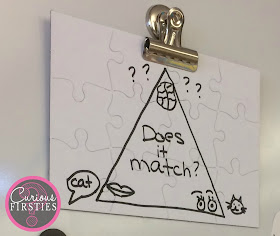Over the summer I read Reading Wellness:
Each chapter focused on one skill that would promote independence in your readers. I loved the layout of this book because it got right down to the lesson(s) to use in order to make this happen in your classroom. My sister and I wrote about a lesson called "Does it match?" over at the Adventures in Literacy Land. This chapter focused on alignment when reading. I loved the lesson when I read about it in July, but then actually DOING it....WOW! It turned out better than I had anticipated.
The authors,
Burkins and Yaris, explain that alignment must occur for
readers through print and meaning. Both must be attended to and in alignment. The authors explain that print and meaning are comparable to a puzzle: the
pieces versus the puzzle. Which one is more important? Both. They are
essential and important to the activity of putting a puzzle together.
Burkins and Yaris go on to say that by offering explicit strategies such as "get
your mouth ready" or "look for a small word inside the big word," we are
not allowing students to be decision makers or problem solvers. They
state that we are "...telling them how to solve a problem rather than
supporting them in solving the problem themselves." (p71)
These statement really struck me and stuck with me as my teammate, Karen, and I prepared for our school year. We have always taught with reading strategies like the ones described by the authors. How do we help our new, young readers to "make it match?"
So we devised a plan...
In previous posts, I have explained that Karen and I team teach our reading strategies by modeling the strategy, asking the students to name what we do, and then asking them to illustrate it with us. This has proven to work well for us because they are ready to practice and use those strategies during guided reading once our lessons are complete. We wanted to do the same this year but with one little (GAME CHANGING) addition.
We started our lesson by asking our students what body parts they use when reading. They came up with: *eyes (to look at words and pictures)
*mouth (to say the words)
*brain (to think about the story)....we may have helped with this one.
As they came up with these body parts, I drew them on this blank puzzle. Then I connected them with a triangle and wrote the words "Does it match?" We explained that good readers use all three of these body parts when they read. Then we told them that they will get stuck on words and will need to use strategies to help them solve the word but that they are always thinking "Does it match? Is what I see, what I'm saying, and what I'm thinking about the story all match?"
Once we had laid this foundation, Karen and I continued with our lessons on individual strategies. But this year we wrote each one on a puzzle piece. We kept reinforcing that our brain, eyes, and mouth must match in order for the story to make sense. My goal is to use this phrase, "Does it match?" when a student needs to be prompted to solve a word while reading.
A side note...another discovery that we made was that we also needed to start using this question during writing instruction. Students need to make sure what they saying (or writing), what they draw (or see), and what they are thinking (about the story) all match in order for their writing to make sense. Connection made!! Yay!!!
I can't wait to see how this change in language changes our readers!
Em




That's a great question to ask. I've never seen this book, but I recognize the author names. It must be good.
ReplyDelete